Electric Consumption Forecast for Ships Using Multivariate Bayesian Optimization-SE-CNN-LSTM
Abstract
1. Introduction
2. Theoretical Background
2.1. Convolutional Neural Network (CNN)
2.2. Long Short-Term Memory (LSTM)
2.3. Squeeze and Excitation (SE) Block
2.4. Bayesian Optimization
2.5. Data Description
3. Proposed Model
3.1. Electric Consumption Forecast for Ships by a Multivariate CNN-LSTM Network with SE Using Bayesian Optimization
3.2. Model Training Process
- Step 1.
- Parameter initialization
- Step 2.
- Searching hyperparameters
- Step 3.
- Forecasting
4. Results and Discussion
5. Conclusions
- Bayesian optimization is suitable for determining hyperparameters for the proposed CNN-LSTM with the SE model by combining loss functions and hyperparameters. Compared with traditional methods, such as grid and random search, this process can determine the parameters more rapidly.
- This study used the parallel and direct CNN-LSTM load estimation models to evaluate the performance of the proposed model. According to the comparative test results, the proposed model demonstrated the best ship power load forecasting performance.
- More data are required to enhance the estimation performance of the proposed model for intermittent heavy loading.
Author Contributions
Funding
Institutional Review Board Statement
Informed Consent Statement
Data Availability Statement
Conflicts of Interest
References
- Lee, J.-H.; Oh, J.-H.; Oh, J.-S. Battery Control Algorithm for Merchant Ships Using Load Usage Area. In Proceedings of the International Conference on Electrical, Computer, Communications and Mechatronics Engineering (ICECCME), Reduit, Mauritius, 7–8 October 2021. [Google Scholar]
- Yang, X.; Bai, G.; Schmidhalter, R. Shore to Ship Converter System for Energy Saving and Emission Reduction. In Proceedings of the 8th International Conference on Power Electronics—ECCE Asia, Jeju, Republic of Korea, 30 May 2011; pp. 2081–2086. [Google Scholar]
- Chin, C.S.; Tan, Y.-J.; Kumar, M.V. Study of Hybrid Propulsion Systems for Lower Emissions and Fuel Saving on Merchant Ship during Voyage. J. Mar. Sci. Eng. 2022, 10, 393. [Google Scholar] [CrossRef]
- Jang, J.-H.; Oh, J.-S. The Study on a Ship Energy Management System Applied Rechargeable Battery. J. Korean Soc. Mar. Eng. 2014, 38, 202–207. [Google Scholar] [CrossRef]
- Abdelmoula, A.-A.; Khalifa, M.; Mohamed, Y.; Mohammed, Q. Toward Energy Saving and Environmental Protection by Implementation of Autonomous Ship. In Proceedings of the 2018 19th IEEE Mediterranean Electrotechnical Conference (MELECON), Marrakech, Morocco, 2–7 May 2018. [Google Scholar]
- Nyanya, M.N.; Vu, H.B.; Schönborn, A.; Olçer, A.I. Wind and Solar Assisted Ship Propulsion Optimisation and Its Application to a Bulk Carrier. Sustain. Energy Technol. Assess. 2021, 47, 101397. [Google Scholar] [CrossRef]
- Jayasinghe, S.G.; Suryawanshi, U.; Sheikh, A.; Alahakoon, S. Fuel Saving with a Hybrid Power System for an Electric Ferry. In Proceedings of the 14th Conference on Industrial and Information Systems (ICIIS), Kandy, Sri Lanka, 18–20 December 2019; pp. 255–259. [Google Scholar]
- Kistner, L.; Bensmann, A.; Hanke-Rauschenbach, R. Optimal Design of Power Gradient Limited Solid Oxide Fuel Cell Systems with Hybrid Storage Support for Ship Applications. Energy Convers. Manag. 2021, 243, 114396. [Google Scholar] [CrossRef]
- Chen, H.; Zhang, Z.; Guan, C.; Gao, H. Optimization of Sizing and Frequency Control in Battery/Supercapacitor Hybrid Energy Storage System for Fuel Cell Ship. Energy 2020, 197, 117285. [Google Scholar] [CrossRef]
- Bassam, A.M.; Phillips, A.B.; Turnock, S.R.; Wilson, P.A. Development of a Multi-scheme Energy Management Strategy for a Hybrid Fuel Cell Driven Passenger Ship. Int. J. Hydrogen Energy 2017, 42, 623–635. [Google Scholar] [CrossRef]
- Wu, S.; Miao, B.; Chan, S.H. Feasibility Assessment of a Container Ship Applying Ammonia Cracker-Integrated Solid Oxide Fuel Cell Technology. Int. J. Hydrogen Energy 2022, 47, 27166–27176. [Google Scholar] [CrossRef]
- Dai, X.; Sheng, K.; Shu, F. Ship Power Load Forecasting Based on PSO-SVM. Math. Biosci. Eng. 2022, 19, 4547–4567. [Google Scholar] [CrossRef]
- Zhang, Y.; Zhou, Q.; Sun, C.; Lei, S.; Liu, Y.; Song, Y. RBF Neural Network and ANFIS-Based Short-Term Load Forecasting Approach in Real-Time Price Environment. IEEE Trans. Power Syst. 2008, 23, 853–858. [Google Scholar] [CrossRef]
- Al-Hamadi, H.M. Long-Term Electric Power Load Forecasting Using Fuzzy Linear Regression Technique. In Proceedings of the IEEE Power Engineering and Automation Conference, Wuhan, China, 8–9 September 2011. [Google Scholar]
- Tian, M.; Alattas, K.; El-Sousy, F.; Alanazi, A.; Mohammadzadeh, A.; Tavoosi, J.; Mobayen, S.; Skruch, P. A New Short Term Electrical Load Forecasting by Type-2 Fuzzy Neural Networks. Energies 2022, 15, 3034. [Google Scholar] [CrossRef]
- Bakar, N.N.A.; Bazmohammadi, N.; Çimen, H.; Uyanik, T.; Vasquez, J.C.; Guerrero, J.M. Data-Driven Ship Berthing Forecasting for Cold Ironing in Maritime Transportation. Appl. Energy 2022, 326, 119947. [Google Scholar] [CrossRef]
- Kiranyaz, S.; Avci, O.; Abdeljaber, O.; Ince, T.; Gabbouj, M.; Inman, D.J. 1D Convolutional Neural Networks and Applications: A Survey. Mech. Syst. Signal Process. 2021, 151, 107398. [Google Scholar] [CrossRef]
- Avci, O.; Abdeljaber, O.; Kiranyaz, S.; Hussein, M.; Inman, D.J. Wireless and Real-Time Structural Damage Detection: A Novel Decentralized Method for Wireless Sensor Networks. J. Sound Vib. 2018, 424, 158–172. [Google Scholar] [CrossRef]
- Karim, F.; Majumdar, S.; Darabi, H.; Harford, S. Multivariate LSTM-FCNs for Time Series Classification. Neural Netw. 2019, 116, 237–245. [Google Scholar] [CrossRef] [PubMed]
- Candelieri, A.; Giordani, I.; Archetti, F.; Barkalov, K.; Meyerov, I.; Polovinkin, A.; Sysoyev, A.; Zolotykh, N. Tuning Hyperparameters of a SVM-Based Water Demand Forecasting System through Parallel Global Optimization. Comput. Oper. Res. 2019, 106, 202–209. [Google Scholar] [CrossRef]
- Thiede, L.A.; Parlitz, U. Gradient Based Hyperparameter Optimization in Echo State Networks. Neural Netw. 2019, 115, 23–29. [Google Scholar] [CrossRef]
- Yeniay, Ö. Penalty Function Methods for Constrained Optimization with Genetic Algorithms. Math. Comput. Appl. 2005, 10, 45–56. [Google Scholar] [CrossRef]
- Stochino, F.; Lopez Gayarre, F.L. Reinforced Concrete Slab Optimization with Simulated Annealing. Appl. Sci. 2019, 9, 3161. [Google Scholar] [CrossRef]
- Wu, T.; Shi, X.; Liao, L.; Zhou, C.; Zhou, H.; Su, Y. A Capacity Configuration Control Strategy to Alleviate Power Fluctuation of Hybrid Energy Storage System Based on Improved Particle Swarm Optimization. Energies 2019, 12, 642. [Google Scholar] [CrossRef]
- Snoek, J.; Larochelle, H.; Adams, R.P. Practical Bayesian Optimization of Machine Learning Algorithms. Adv. Neural Inf. Process. Syst. 2012, 25, 2960–2968. [Google Scholar]
- Zhou, J.; Qiu, Y.; Zhu, S.; Armaghani, D.J.; Khandelwal, M.; Mohamad, E.T. Estimating of the TBM Advance Rate under Hard Rock Conditions Using XGBoost and Bayesian Optimization. Undergr. Space 2021, 6, 506–515. [Google Scholar] [CrossRef]
- Zhou, J.; Li, X.; Shi, X. Long-Term Prediction Model of Rockburst in Underground Openings Using Heuristic Algorithms and Support Vector Machines. Saf. Sci. 2012, 50, 629–644. [Google Scholar] [CrossRef]
- Zhou, J.; Qiu, Y.G.; Zhu, S.; Armaghani, D.J.; Li, C.; Nguyen, H.; Yagiz, S. Optimization of Support Vector Machine through the Use of Metaheuristic Algorithms in Forecasting TBM Advance Rate. Eng. Appl. Artif. Intell. 2021, 97, 104015. [Google Scholar] [CrossRef]
- Aoki, M. On Some Convergence Questions in Bayesian Optimization Problems. IEEE Trans. Autom. Control 1965, 10, 180–182. [Google Scholar] [CrossRef]
- Bergstra, J.; Bardenet, R.; Kégl, B.; Bengio, Y. Algorithms for Hyper-parameter Optimization. In Proceedings of the 25th Annual Conference on Neural Information Processing Systems, Granada, Spain, 12–15 December 2011; p. hal-00642998f. [Google Scholar]
- Shahriari, B.; Swersky, K.; Wang, Z.; Adams, R.P.; de Freitas, N. Taking the Human out of the Loop: A Review of Bayesian Optimization. Proc. IEEE 2016, 104, 148–175. [Google Scholar] [CrossRef]
- Kim, J.H.; Choi, J.E.; Choi, B.J.; Chung, S.H. Twisted Rudder for Reducing Fuel-Oil Consumption. Int. J. Nav. Archit. Ocean Eng. 2014, 6, 715–722. [Google Scholar] [CrossRef]
- Elkafas, A.G.; Elgohary, M.M.; Zeid, A.E. Numerical Study on the Hydrodynamic Drag Force of a Container Ship Model. Alex. Eng. J. 2019, 58, 849–859. [Google Scholar] [CrossRef]
- Ahmed, R.; Sreeram, V.; Mishra, Y.; Arif, M.D. A Review and Evaluation of the State-of-the-Art in PV Solar Power Forecasting: Techniques and Optimization. Renew. Sustain. Energy Rev. 2020, 124, 109792. [Google Scholar] [CrossRef]
- Sheng, D.D.; Tian, R.L.; Xun, G.; Yan, Y.; Shi, J.H. Traffic Flow Forecasting Based on Hybrid Deep Learning Framework. In Proceedings of the 12th International Conference on Intelligent Systems and Knowledge Engineering, Nanjing, China, 24–26 November 2017. [Google Scholar]
- Agga, A.; Abbou, A.; Labbadi, M.; Houm, Y.E.; Ou Ali, I.H.O. CNN-LSTM: An Efficient Hybrid Deep Learning Architecture for Predicting Short-Term Photovoltaic Power Production. Electr. Power Syst. Res. 2022, 208, 107908. [Google Scholar] [CrossRef]
- Kim, J.Y.; Lee, J.H.; Oh, J.H.; Oh, J.S. A Comparative Study on Energy Consumption Forecast Methods for Electric Propulsion Ship. J. Mar. Sci. Eng. 2021, 10, 32. [Google Scholar] [CrossRef]
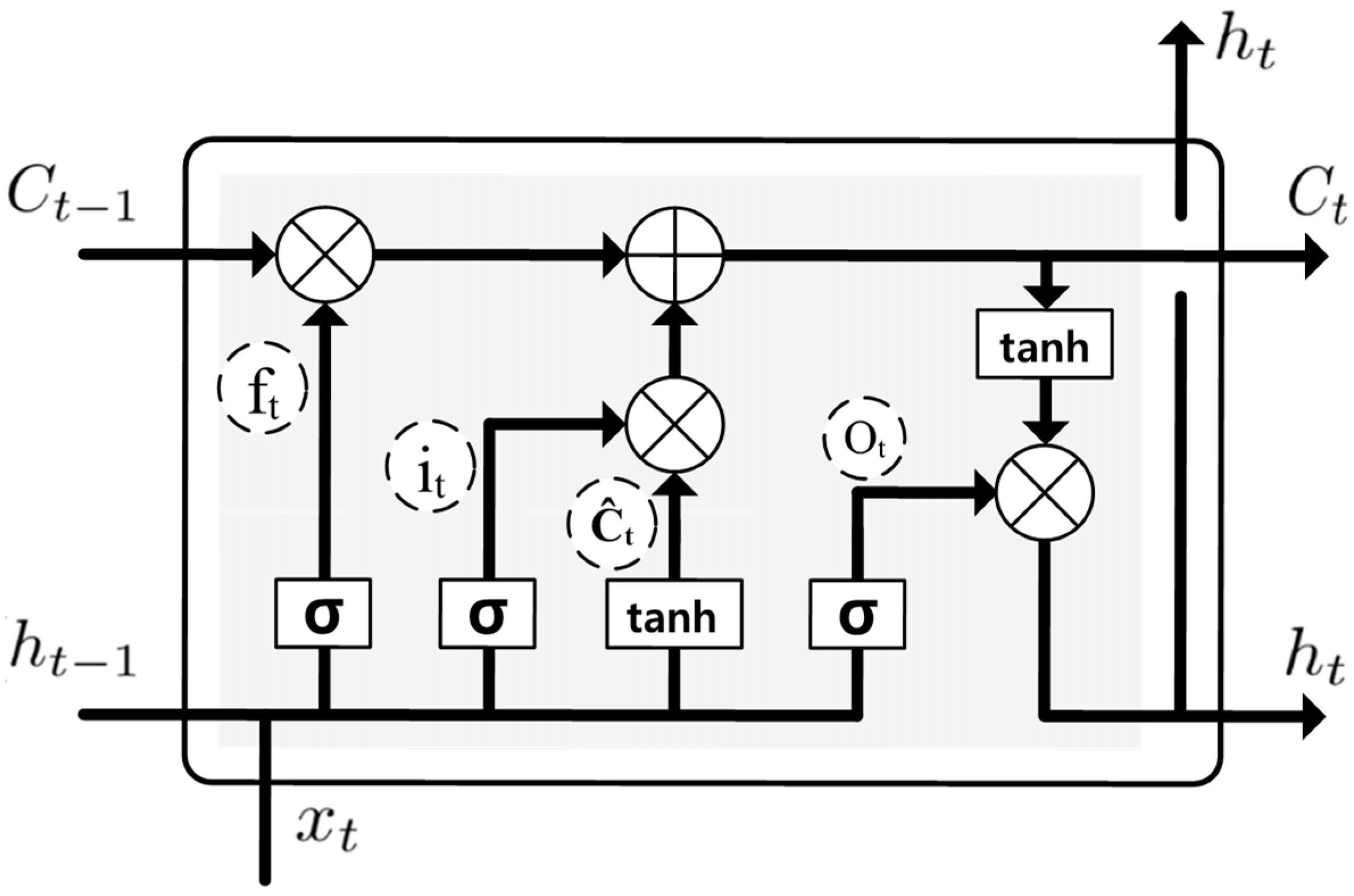
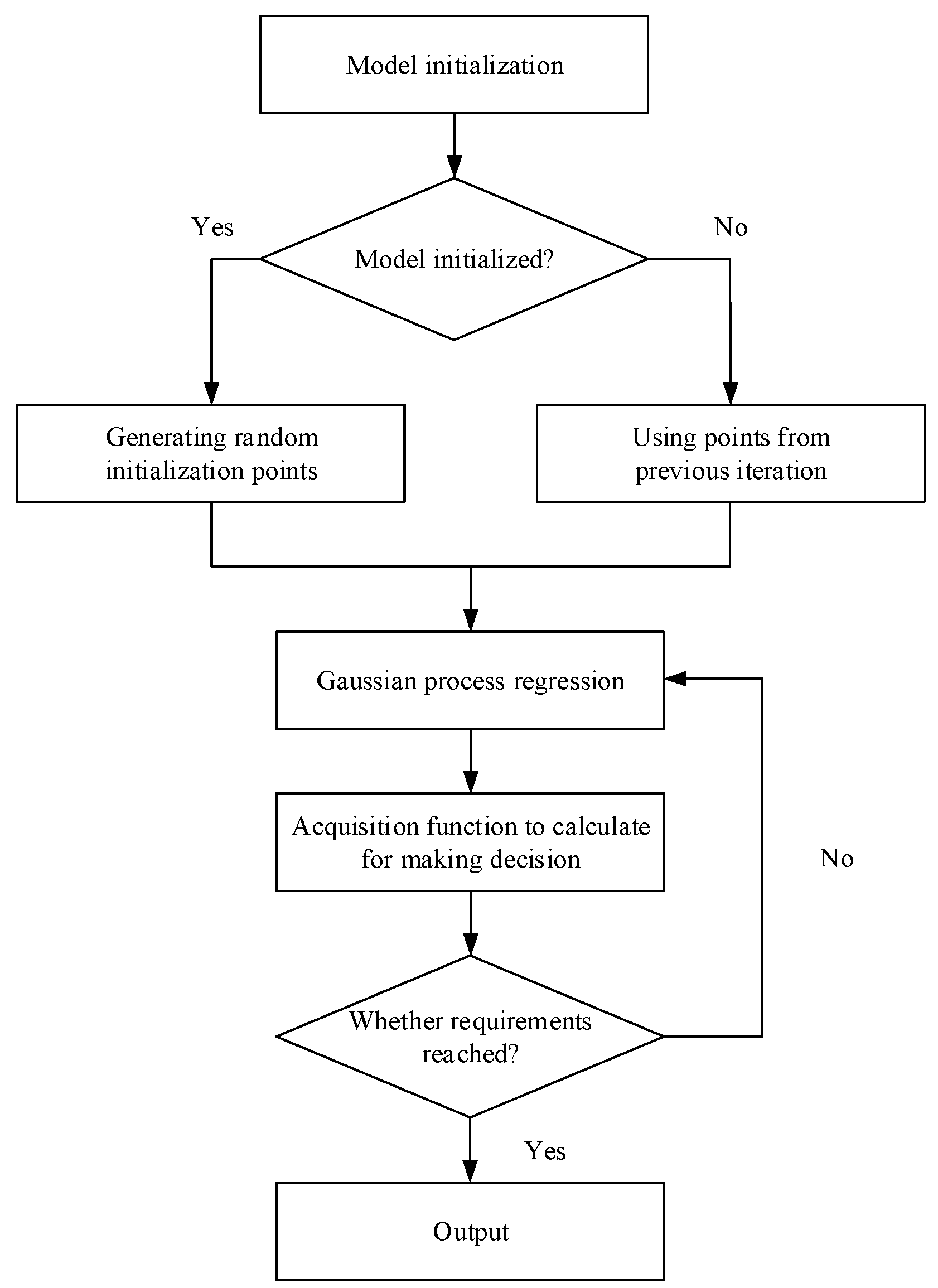
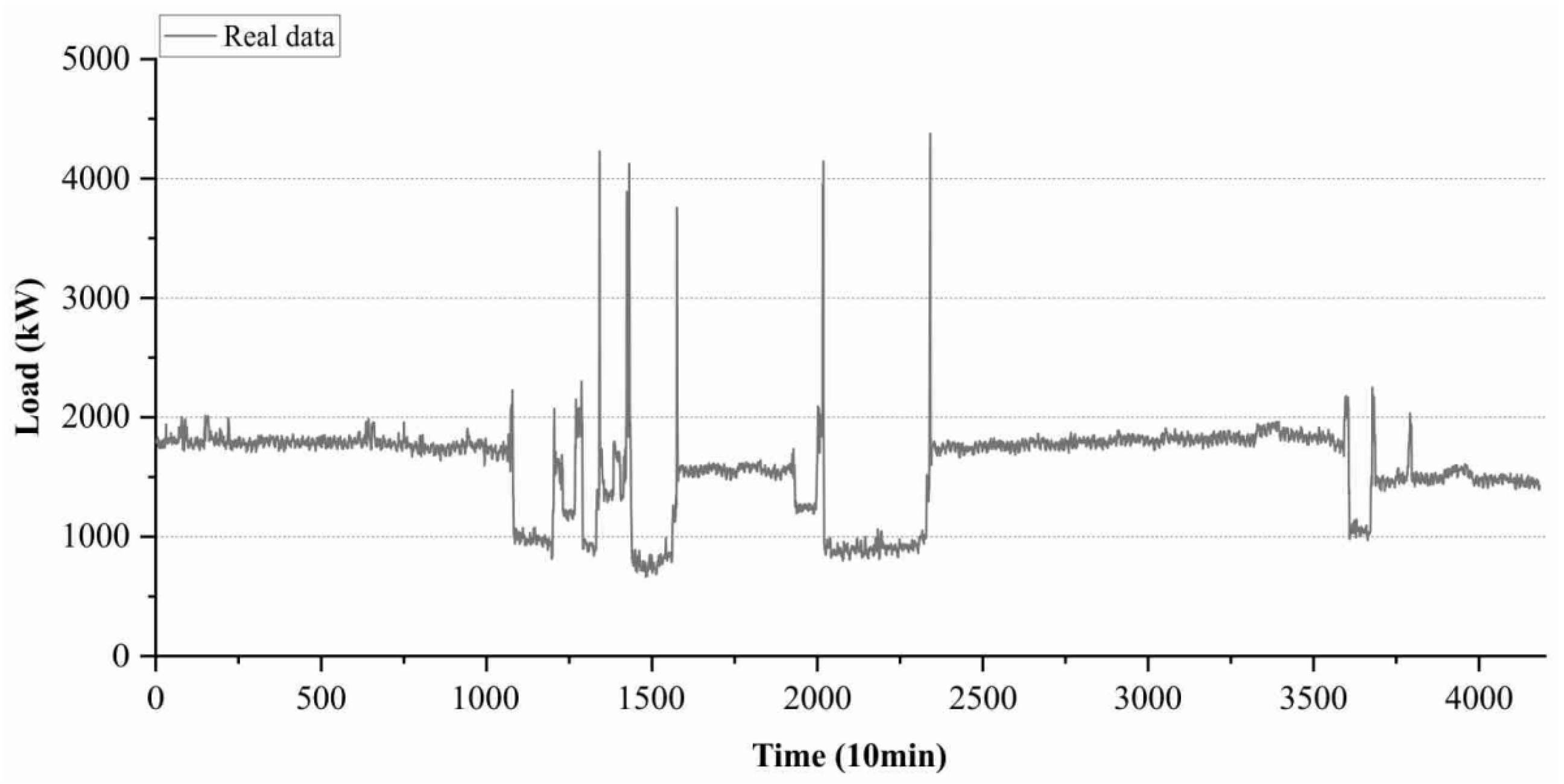
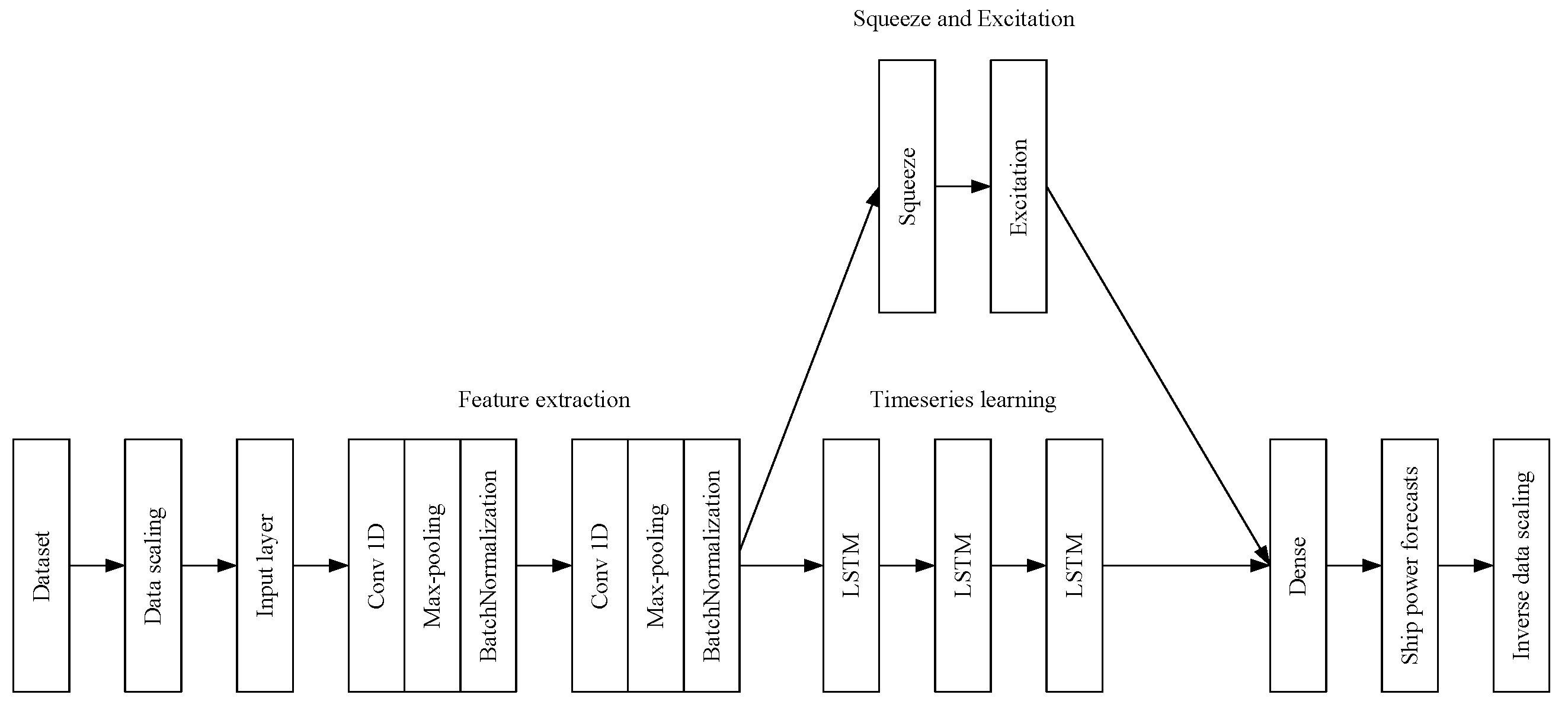

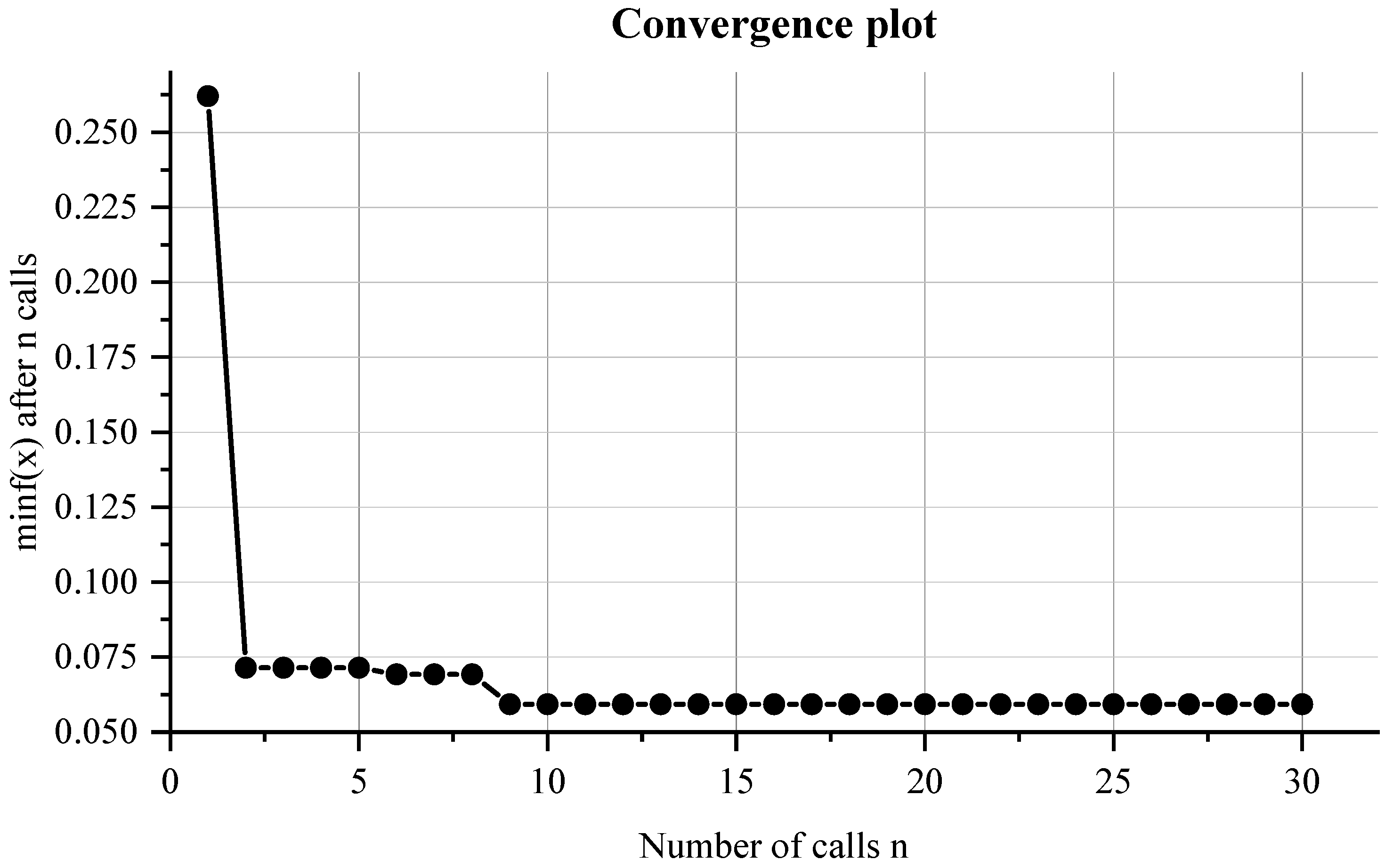
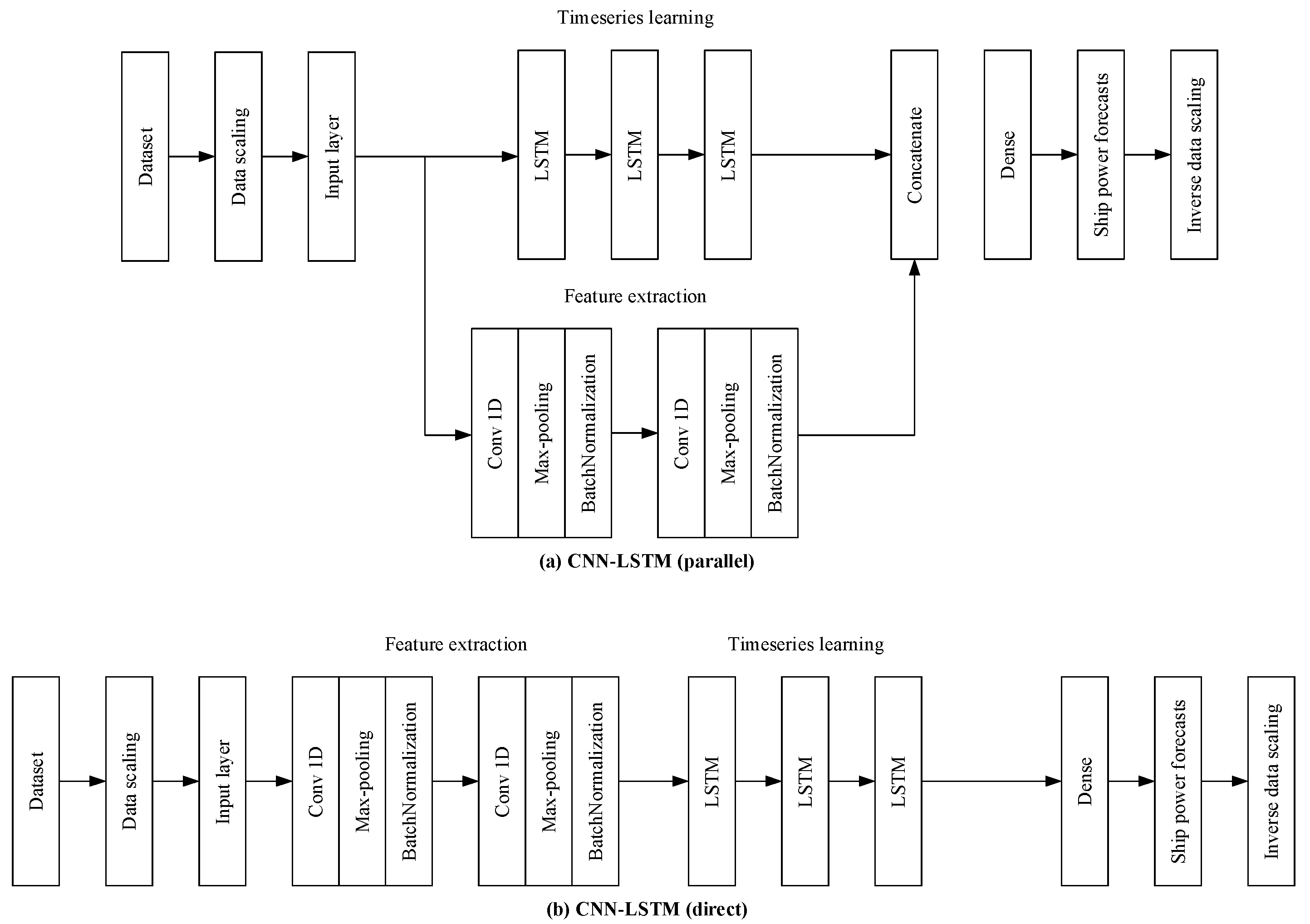
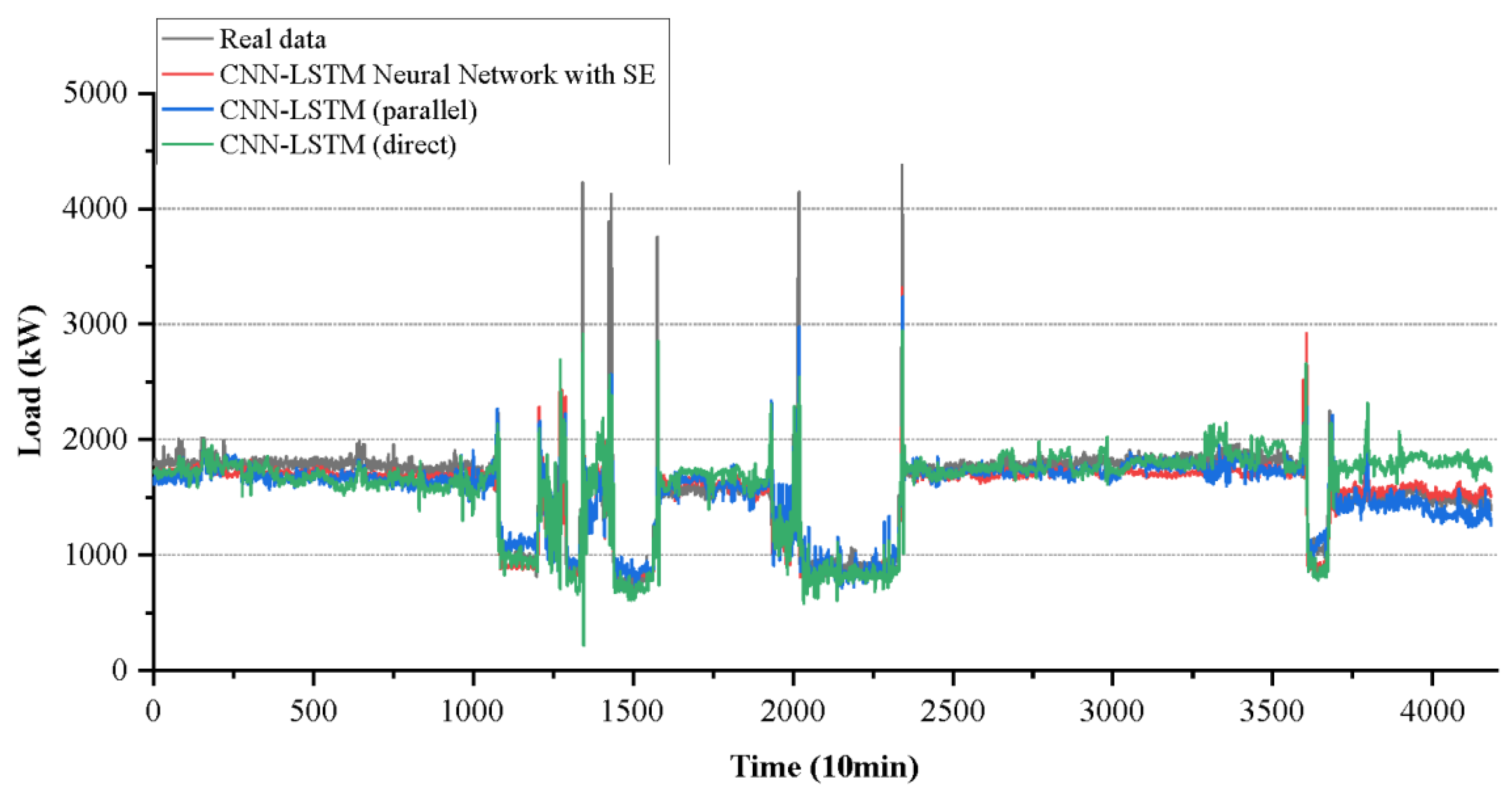
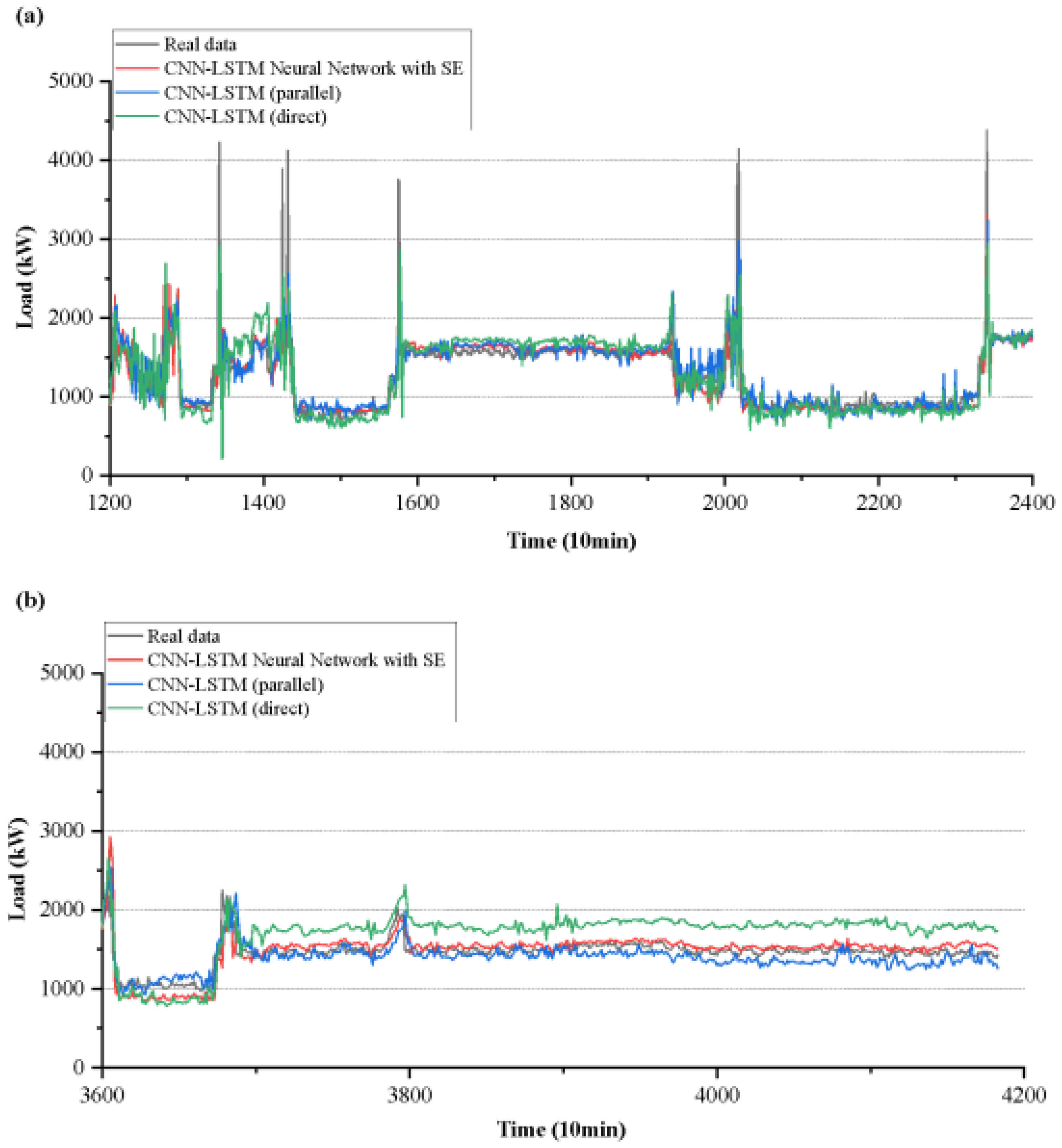
| Attribute | Unit | Range | Average |
|---|---|---|---|
| Electric Load | kW | 585–15,200 | 1567.38 |
| No. 1 Diesel Generator Power | kW | 0–3800 | 240.98 |
| No. 2 Diesel Generator Power | kW | 0–3800 | 604.42 |
| No. 3 Diesel Generator Power | kW | 0–3800 | 323.9 |
| No. 4 Diesel Generator Power | kW | 0–3800 | 401.07 |
| No. 1 Reefer Container Load | kW | 0–130 | 14.19 |
| No. 2 Reefer Container Load | kW | 0–130 | 12.37 |
| No. 3 Reefer Container Load | kW | 0–130 | 24.17 |
| No. 4 Reefer Container Load | kW | 0–130 | 22.21 |
| No. 5 Reefer Container Load | kW | 0–130 | 21.51 |
| No. 6 Reefer Container Load | kW | 0–130 | 19.76 |
| Rudder Angle | Degree | −38–38° | −1.31 |
| Water Speed | m·s−1 | −4.36–16.66 | 9.85 |
| Wind Speed | m·s−1 | 0–24.8 | 6.23 |
| Wind Angle | Degree | 0–360° | 155.08 |
| Parameter Name | Initial Parameter Value |
|---|---|
| Number of first 1D convolution layer filter | 10 |
| Size of first 1D convolution layer kernel | 3 |
| Number of second 1D convolution layer filter | 10 |
| Size of second 1D convolution layer kernel | 3 |
| Number of neurons in excitation layer input | 10 |
| Number of neurons in excitation layer output | 10 |
| Number of neurons in first LSTM | 16 |
| Number of neurons in second LSTM | 16 |
| Number of neurons in third LSTM | 16 |
| Value of learning rate | 10−6–10−3 |
| Value of batch size | 16 |
| Parameter Name | Search Space |
|---|---|
| Number of first 1D convolution layer filter | 10–128 |
| Size of first 1D convolution layer kernel | 3–128 |
| Number of second 1D convolution layer filter | 10–128 |
| Size of second 1D convolution layer kernel | 3–128 |
| Number of neurons in excitation layer input | 10–1024 |
| Number of neurons in excitation layer output | 10–1024 |
| Number of neurons in first LSTM | 16–1024 |
| Number of neurons in second LSTM | 16–1024 |
| Number of neurons in third LSTM | 16–1024 |
| Value of learning rate | 10−6–10−3 |
| Value of batch size | 16–256 |
| Parameter Name | Selected Hyperparameter Value |
|---|---|
| Number of first 1D convolution layer filter | 90 |
| Size of first 1D convolution layer kernel | 3 |
| Number of second 1D convolution layer filter | 128 |
| Size of second 1D convolution layer kernel | 3 |
| Number of neurons in excitation layer input | 1024 |
| Number of neurons in excitation layer output | 194 |
| Number of neurons in first LSTM | 512 |
| Number of neurons in second LSTM | 528 |
| Number of neurons in third LSTM | 194 |
| Value of learning rate | 0.001 |
| Value of batch size | 256 |
| Model | RMSE | MAE | MAPE |
|---|---|---|---|
| CNN-LSTM with SE | 148.81 | 90.41 | 5.73 |
| CNN-LSTM (parallel) | 159.85 | 100.29 | 6.52 |
| CNN-LSTM (direct) | 202.78 | 134.43 | 8.83 |
Disclaimer/Publisher’s Note: The statements, opinions and data contained in all publications are solely those of the individual author(s) and contributor(s) and not of MDPI and/or the editor(s). MDPI and/or the editor(s) disclaim responsibility for any injury to people or property resulting from any ideas, methods, instructions or products referred to in the content. |
© 2023 by the authors. Licensee MDPI, Basel, Switzerland. This article is an open access article distributed under the terms and conditions of the Creative Commons Attribution (CC BY) license (https://creativecommons.org/licenses/by/4.0/).
Share and Cite
Kim, J.-Y.; Oh, J.-S. Electric Consumption Forecast for Ships Using Multivariate Bayesian Optimization-SE-CNN-LSTM. J. Mar. Sci. Eng. 2023, 11, 292. https://doi.org/10.3390/jmse11020292
Kim J-Y, Oh J-S. Electric Consumption Forecast for Ships Using Multivariate Bayesian Optimization-SE-CNN-LSTM. Journal of Marine Science and Engineering. 2023; 11(2):292. https://doi.org/10.3390/jmse11020292
Chicago/Turabian StyleKim, Ji-Yoon, and Jin-Seok Oh. 2023. "Electric Consumption Forecast for Ships Using Multivariate Bayesian Optimization-SE-CNN-LSTM" Journal of Marine Science and Engineering 11, no. 2: 292. https://doi.org/10.3390/jmse11020292
APA StyleKim, J.-Y., & Oh, J.-S. (2023). Electric Consumption Forecast for Ships Using Multivariate Bayesian Optimization-SE-CNN-LSTM. Journal of Marine Science and Engineering, 11(2), 292. https://doi.org/10.3390/jmse11020292






